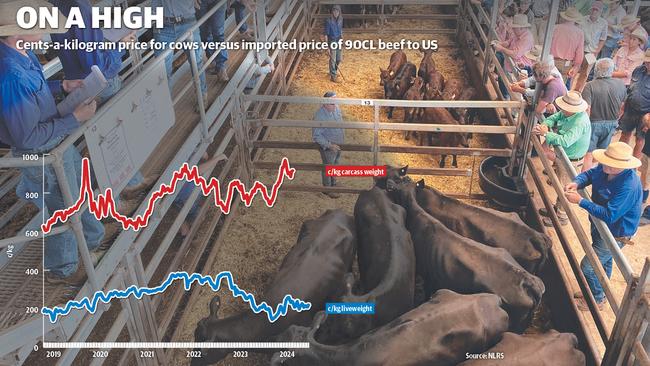Strong prices for cow beef into United States
Australia’s share of beef into the United States is set to rise, but producers are yet to see the full benefits due to a season which has distorted cattle supply and demand.
Exporters are piling grinding beef into the United States. So, mid-way through the year where does the producers side of the cow equation sit?
When June figures are finalised in coming days shipments of Australian beef into the US are expected to be close to 29,000 metric tonnes, or around 40 per cent higher than year ago levels. It would make the US the top export destination for Aussie product as processors target the strong prices available in this market.
US market analysts Steiner Consulting said the ramp-up in sales would mean Australia’s share of the US imported beef market would be about 27 per cent in June, an improvement on the 23 per cent last year and much higher than the 16 per cent level of two years ago.
The US has long been touted as the shining beacon for the global cattle market after its herd number was depleted to a 25-year low following years of drought, reducing its production as it enters a rebuilding cycle.
As the graph on this page shows, the value of 90 chemical lean grinding beef into the US continues to track at high levels, currently trending at around 920c/kg delivered port when values are converted into Australian currency, based on Meat and Livestock Australia data.

It is not the highest the 90CL beef category has been but it is not that far off the peak and is showing signs of ticking up again as the US cattle market gathers momentum on the back of reduced cattle kills.
The latest data out of the US (for the first four weeks of June) had the US cow and bull kill 18 per cent lower than the same month in 2023, and 25 per cent behind the levels of 2022. Contributing to the decline is the US dairy sector, with Steiner Consulting suggesting an improvement in dairy returns and cheaper feed costs had slowed the dairy cow slaughter.
“The focus is often on beef cow slaughter but lost in the discussion is (US) dairy cow slaughter is running about 20 per cent lower than a year ago, often contributing as much if not more to the overall decline in slaughter,” Steiner wrote in its latest market update.
US slaughter cow prices are sitting around 30 per cent higher than a year ago, and its domestic fresh grinding beef prices are now in record territory.
While US fresh beef values have been at a considerable premium to imported frozen grinding beef prices, the gap is starting to tighten as US end users look to secure more supply.
“Imported beef prices continued to climb in tandem with the surging values of domestic fresh lean beef and ongoing uncertainty about lean beef supply later in the year,” Steiner noted this week.
Which brings up the subject of US grinding beef rates compared to the Australian saleyard price for cows.
To refer to the graph, the price difference between the two remains at elevated levels and it can be argued Australian producers are yet to see the full benefits of the surging US market due to the season which has distorted cattle supply and demand.
Currently, the national price average for saleyard cows is 219c/kg liveweight, which converts to about 430c/kg carcass weight on an average yield of 51 per cent. With the 90CL price tracking at 915c/kg, it means the gap is wide at 485c/kg.
The last time the 90CL price was at a similar level of 900c/kg plus was in early 2022 and the saleyard cow price hit a national average of 371c/kg liveweight. Convert the 371c/kg on a 51 per cent yield and it works out at around 720c/kg carcass weight. It means there was a gap of about 200c/kg between the ruling indicators – or nearly half what exists today.
It shows how the dry conditions across parts of the country is at least partly suppressing the cow market, as 2022 was a boom year when producer confidence was running high and herd numbers were being increased.
It is fair to say partly suppressing as there has been changes to cost structures in recent years, including transport and shipping plus wages at abattoirs. But even taking this into account the cow market looks cheap with a lot of upward potential.
Even if you take the mid-ground and put the cow price at 300c/kg liveweight (rather than the 371c/kg it hit when the 90CL price was at today’s level of 915c/kg shipped), it amounts to an extra $400 a head on a 600kg slaughter cow – significant money.
Looking ahead US grinding beef prices often gain momentum into the third quarter of the trading year, as noted by Steiner.
“Big users of imported lean beef are well aware of supply flows and they are currently looking to stay ahead of expected Q3 needs, hence higher prices paid for imported beef.”




